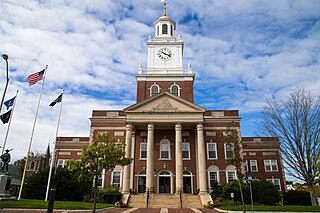
Dover is a city in Strafford County, New Hampshire, United States. The population was 29,987 at the 2010 census, the largest in the New Hampshire Seacoast region and the 4th largest city in the state of New Hampshire. The population was estimated at 32,191 in 2019. It is the county seat of Strafford County, and home to Wentworth-Douglass Hospital, the Woodman Institute Museum, and the Children's Museum of New Hampshire.

The Seacoast Region is the southeast area of the U.S. state of New Hampshire that includes the eastern portion of Rockingham County and the southern portion of Strafford County. The region stretches 13 miles (21 km) along the Atlantic Ocean from New Hampshire's border with Salisbury, Massachusetts, to the Piscataqua River and New Hampshire's border with Kittery, Maine. The shoreline alternates between rocky and rough headlands and areas with sandy beaches. Some of the beaches are bordered by jetties or groins, particularly in the towns of Rye and Hampton. The Seacoast Region includes some inland towns as well, as far west as Epping and as far north as Rochester.

Historic Deerfield is a museum dedicated to the heritage and preservation of Deerfield, Massachusetts, and history of the Connecticut River Valley. Its historic houses, museums, and programs provide visitors with an understanding of New England's historic villages and countryside. It is located in the village of Old Deerfield which has been designated a National Historic Landmark District, and is listed on the National Register of Historic Places. The museum also hosts the Dublin Seminar for New England Folklife.

New Bedford Whaling National Historical Park (NBWNHP) is a United States National Historical Park in New Bedford, Massachusetts, and is maintained by the National Park Service (NPS). The park commemorates the heritage of the world's preeminent whaling port during the nineteenth century.

The Richard Jackson House is a historic house in Portsmouth, New Hampshire. Built in 1664 by Richard Jackson, it is the oldest wood-frame house in New Hampshire. It was designated a National Historic Landmark in 1968. It is now a historic house museum owned by Historic New England, and is open two Saturdays a month between June and October.

The Governor John Langdon House, also known as Governor John Langdon Mansion, is a historic mansion house at 143 Pleasant Street in Portsmouth, New Hampshire, United States. It was built in 1784 by John Langdon (1741-1819), a merchant, shipbuilder, American Revolutionary War general, signer of the United States Constitution, and three-term President of New Hampshire. The house he built for his family showed his status as Portsmouth's leading citizen and received praise from George Washington, who visited there in 1789. Its reception rooms are ornamented by elaborate wood carving in the rococo style. The house was declared a National Historic Landmark in 1974, and is now a house museum operated by Historic New England.

Strawbery Banke is an outdoor history museum located in the South End historic district of Portsmouth, New Hampshire. It is the oldest neighborhood in New Hampshire to be settled by Europeans, and the earliest neighborhood remaining in the present-day city of Portsmouth. It features more than 37 restored buildings built between the 17th and 19th centuries in the Colonial, Georgian, and Federal style architectures. The buildings once clustered around a waterway known as Puddle Dock, which was filled in around 1900. Today the former waterway appears as a large open space.
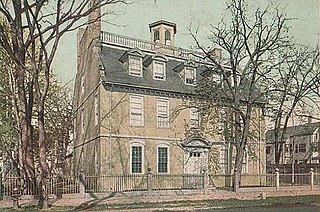
The Warner House, also known as the MacPheadris–Warner House, is a historic house museum at 150 Daniel Street in Portsmouth, New Hampshire, United States. Built 1716–1718, it is the oldest, urban brick house in northern New England, and is one of the finest early-Georgian brick houses in New England. It was declared a National Historic Landmark in 1960, and is listed on the National Register of Historic Places.
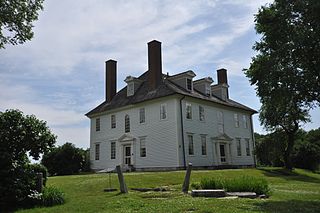
The Jonathan Hamilton House, also known as the Hamilton House, is a historic house at 40 Vaughan's Lane in South Berwick, Maine. Built between 1787 and 1788 by a merchant from Portsmouth, New Hampshire, this National Historic Landmark is a little-altered and high quality late Georgian country house. Acquired by preservationist friends of South Berwick native Sarah Orne Jewett at the turn of the 20th century, it is now a historic house museum owned by Historic New England, open for tours between June and October.

The Gilman Garrison House is a historic house museum at 12 Water Street in Exeter, New Hampshire. Built in 1709, it is a rare surviving example of a First Period garrison house, built with a number of clearly defense-related features. It is owned by Historic New England, which operates the home as a house museum, and was listed on the National Register of Historic Places in 1976.

The Portsmouth Athenæum is an independent membership library, gallery, and museum in Portsmouth, New Hampshire, United States. It preserves and provides access to an extensive collection of manuscripts, rare books, photographs, artworks and artifacts, and digital collections related to local history and genealogy, in addition to a circulating library for its membership. As an intellectual center of the community, it sponsors exhibitions, concerts, lectures, and other educational and cultural programs. The building, dating to 1805, has been listed on the National Register of Historic Places since 1973.
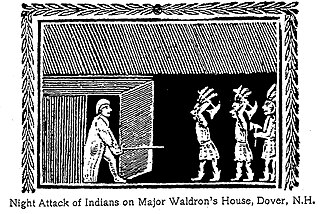
Major Richard Waldron was an English-born merchant, soldier, and government official who rose to prominence in early colonial Dover, New Hampshire. His presence spread to greater New Hampshire and neighboring Massachusetts. He was the second president of the colonial New Hampshire Royal Council after it was first separated from Massachusetts.

The Raid on Dover happened in Dover, New Hampshire on June 27–28, 1689. Led by Chief Kancamagus, it began King William's War, a series of Indian massacres orchestrated by Jean-Vincent d'Abbadie de Saint-Castin and Father Louis-Pierre Thury.

The Weeks House, also known as the Old Brick House, is a historic house museum on Weeks Avenue in Greenland, New Hampshire. Built about 1710, it is one of the oldest brick buildings in New England. It was built by an early colonial member of New Hampshire's politically prominent Weeks family, and is now maintained by a family association. The house was listed on the National Register of Historic Places in 1975.

Freese's Tavern is a historic tavern and general store at 1011 Whittier Highway, the northwest corner of the junction of New Hampshire Routes 109 and 25 in Moultonborough, New Hampshire. With a building history dating to about 1780, and a continuous history of operation as a tavern, general store, post office, library, and town hall, it is one of the oldest establishments of its type in the United States. It is presently known as The Old Country Store, and includes museum displays on its history. The building was listed on the National Register of Historic Places in 1982.

The Exeter Waterfront Commercial Historic District encompasses the historic commercial and residential waterfront areas of Exeter, New Hampshire. The district extends along the north side of Water Street, roughly from Main Street to Front Street, and then along both sides of Water and High streets to the latter's junction with Portsmouth Street. It also includes properties on Chestnut Street on the north side of the Squamscott River. This area was where the early settlement of Exeter took place in 1638, and soon developed as a shipbuilding center. The district was listed on the National Register of Historic Places in 1980. It was enlarged in 1986 to include the mill complex of the Exeter Manufacturing Company on Chestnut Street.
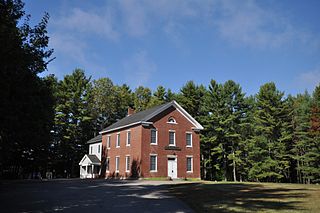
The Newington Center Historic District encompasses the historic civic heart of Newington, New Hampshire. It consists of a section of Nimble Hill Road between its junction with Little Bay Road, and a gate at the southern end marking the start of territory formerly associated with Pease Air Force Base. This area includes the town common, laid out in 1640, a cluster of civic buildings, and several private residences, as well as remnants of the state's oldest town forest. The district was listed on the National Register of Historic Places in 1987; in 1991 an additional 69 acres (28 ha) of former town forest, now part of the airfield, were added to the district.

The Portsmouth Cottage Hospital was the first hospital built in the city of Portsmouth, New Hampshire. Opened in 1884, it was one of the first hospitals in New Hampshire, and it served as the city's primary hospital facility until 1986, when Portsmouth Regional Hospital opened. Its 1895 campus has been repurposed to house city offices and the police station, and a senior living facility. A portion of that facility, representing its oldest buildings, was listed on the National Register of Historic Places in 1996.
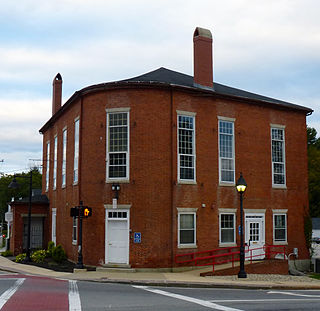
The Durham Historic District encompasses a portion of the original historic settlement area of Durham, New Hampshire. It extends along Newmarket Road from its northern junction with Laurel Lane to a three-way junction with Main Street and Dover Road. From there it extends along Main Street to Madbury Road. This area, known in early colonial days as the Oyster River Plantation, for the Oyster River which bisects it, was first settled in 1649. It was developed in the 18th century as a significant shipbuilding center. The district was listed on the National Register of Historic Places in 1980.

The Portsmouth Downtown Historic District encompasses the historic urban core of Portsmouth, New Hampshire. With a history dating to the 17th century, Portsmouth was New Hampshire's principal seaport and the center of its economy for many decades, and the architecture of its urban center is reflective of nearly four centuries of history. The district is roughly L-shaped, radiating from the downtown Market Square area to South Street in the south and Madison and Columbia streets in the west, with more than 1,200 historically significant buildings. It was listed on the National Register of Historic Places in 2017. The district includes 35 previous listings on the National Register, and five National Historic Landmarks.























